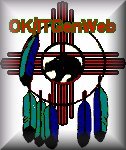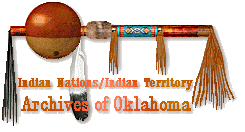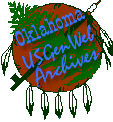Pre-history preface by Pat Smith:
Pre history is speculative, and far from exact. Archaeologists and the
scientific community now hold as conclusive that mankind first arrived
in North America from Asia via Beringia, the Bering Strait Land Bridge,
during the late Pleistocene Age, perhaps 50,000 BC. Generally, over many
thousands of years, migration routes were influenced by receding glaciers
of the Wisconsin Period, later driven by cultural expansion of dominant
societies. In the study if Native American Indians it is convenient to divide the
Americas into geographical regions. Tribes within each region exhibit a
significant number of cultural traits. And so it is with the Mound Builders, the Adena and Hopewell cultures
that lived 1,000 BC -700 AD, and ranged throughout the eastern woodlands
of present day America and extended into the Great Plains. The Temple Mound
Builders, or Mississippian culture, lived 700 AD-1500 AD and migrated to
the vicinity of present day Mississippi, although one culture with numerous
Mississippian traits, the Natchez Indians along the lower Mississippi River,
lasted well into the 18th century. The Mississippian cultural influence
ranged from the Gulf of Mexico to the Great Lakes to the Northern Great
Plains to the foothills of the Rockies. The Temple Mound Builders were
master farmers and had an elaborate trade network among themselves, and
with other tribes. They had a complex social structure, and a rigid caste
system. They built mounds not only for burial, like the Adenas and Hopewells,
but also huge cerimonial, or temple mounds. It is
this Mississippian culture that migrated, under duress, to Oklahoma and Indian
Territory in the 19th century. Spiro, in present day LeFlore county, was a
center for the Mound Builder culture.
Ref: Atlas of the North American Indian, Carl
Waldman/Molly Braun, 1985
Recent history as presented by the Choctaw Nation:
The Choctaw Indian Nation traces its ancestry to Mississippi and some
sections of Alabama. Legends tell that the Choctaw People originated from
"Ninah Waya",
a sacred hill near Nozapter, Mississippi. The name "Ninah Waya"
means "Productive Mountain" and is often referred to as "The
Mother Mound". The "emergence
myth" is a part of Choctaw history.
Culturally, the Choctaws have always honored their women as the head
of every family household. They were, and still are today, considered the
care-takers of our children, our elders, and the home.
In 1830, the Treaty of Dancing Rabbit Creek forcibly relocated the entire
Choctaw nation from their homeland in Mississippi west to what is now known
as Southeastern Oklahoma. Over twenty thousand Choctaws were moved
on this long journey. Seven thousand survived this removal on what
has come to be called "The Trail of Tears".
The Choctaw population has grown from the original seven thousand survivors
to more than seventy thousand. The Choctaw People have overcome enormous
obstacles in their quest for self-reliance in a changing and often hostile
world.
During the 1970's, The elected Tribal Chief had the difficult task of
re-establishing the sovereignty of the Choctaw Nation. Under the leadership
of Chief Hollis Roberts and a progressive twelve elected Tribal Council
Representatives, the Choctaw Nation has established a positive direction
of Tribal Government to the benefit of the Choctaw People.
In 1975 the Chief wished to establish the Choctaw Nation administrative
offices at the historic Presbyterian College building in Durant, Oklahoma.
This building was originally established in 1894 as a school for Indian
youths and was known as the Calvin Institute. Support for the school came
from the Choctaw Nation and the Presbyterian Churches until it was closed
in 1960 due to financial difficulties.
Reacquisition and renovation of the building allowed the centralization
of the Choctaw Government which permits more effective Choctaw Government
Administration. Guests are always welcome and tours are available by contacting
the Choctaw Nation of Oklahoma.
Chief Hollis Roberts and the Twelve Tribal Council Representatives meet
at the historic Choctaw capitol Building located in Tuskahoma, Oklahoma.
In September of 1884, construction of the Choctaw Nation's capitol was
completed. The Choctaw capitol Building was the center of government for
the Choctaw Nation until 1907. That year, the State of Oklahoma attempted
to dissolve the Choctaw Nation Government and the Choctaw citizens were
declared general citizens of the State of Oklahoma.
In 1977, a group of
Choctaws petitioned the Federal court, asking that the 1860 Choctaw Constitution
be legally declared the valid Constitution of the Choctaw Nation. the Choctaw
people voted in 1979 for and adopted the document which would serve as a guide
for the government and proposed constitution. In 1981 the Federal Courts did
declare that the 1860 Choctaw Constitution was valid. The Choctaw Nation of
Oklahoma operates under a written Constitutional form of Government ratified by
the Choctaw people on July 9, 1983.
Today, the Choctaw Nation provides many services for the Choctaw people.
Some of those services include:
- Tribal newspaper "BISHINIK"
- Community Health Services, Talihina Hospital and Clinics.
- Housing Programs
- Environmental Health
- Transportation
- Job Training
- Education Program for the
- Numerous Community Centers for local activities
- Choctaw adults and youths
- Food Distribution
- Programs for Elderly, and a modern nursing home
- Economic Development of industries to create jobs
The Historic Choctaw Capitol Building houses the Choctaw nation's National
Museum and Judicial Department Court System. The Choctaw national Museum
has a wide assortment of historic and cultural exhibits which include information
and displays on the Choctaw Light Horsemen and the original Choctaw Code
Talkers from World War I and World War II. I November 1989, France presented
the highest honor that country can bestow, "knight of the National
Order of Merit of France" to the Choctaw Code Talkers for their efforts
in World War I.
The Light Horsemen were the Law Enforcement arm of the historic Choctaw
Nation. Artifacts and history of these colorful Choctaw Lawmen is also
displayed at the museum. Legends tell that on occasions, the spirit of
the Light Horsemen may been seen riding across the Council Grounds and
in their guard quarters in the Choctaw Capitol Building at Tuskahoma.
The Choctaw Capitol Building is one of the outstanding Historical markers
for the Choctaw Nation and hosts the annual Choctaw Nation Labor Day Festival.
One of the largest and most attractive events in Oklahoma today is the
Annual Choctaw Labor Day Celebration. This event has become a continuing
tradition among the Choctaw People, hosting thousands of visitors at the
Historic Council House grounds. Traditional Cultural Activities, Annual
Choctaw Princess Pageant, Traditional Foods, Arts and Crafts, Sporting
games, camping, fishing, and musical entertainment are a few of the activities
at the celebration. The festival includes many family reunions and features
many celebrities, entertainers, Tribal leaders, Choctaw Tribal Council
Representatives, and Chief Hollis Roberts who meets with the Choctaw people
and greets the many welcome visitors from all over the world. One of the
highlights of the event is Chief Hollis Roberts annual "State of the
Nation Address" to the Choctaw people.
In December 1987, the Choctaw Nation opened the doors of their 28,000
square foot Choctaw Bingo Palace and became the first America Indian bingo
hall to have a one million dollar winner. Profits from the Choctaw Bingo
benefit the Choctaw people and have helped start many projects and services
in the Choctaw Nation.
The Choctaw Travel Plaza opened in August 1989, and is located three
miles south of Durant on Highway 69-75. It offers tourist, travelers and
truckers fuel, food, gifts and customary Choctaw hospitality.
Arrowhead Lodge and Resort, located on beautiful Lake Eufaula, was purchased
from the State of Oklahoma in march 1986. The Choctaw nation has renovated
and remodeled Arrowhead Resort. it now boasts of continued growth, and
a 2,000 seat convention center is presently under construction. Choctaw
management has made Arrowhead Resort one of the more beautiful tourist
attractions in Oklahoma. It is a favorite meeting place for numerous conventions
and pow wows throughout the year. The resort offers spacious rooms, swimming,
lake recreations, and has the tallest free standing fireplace in the world.
Historic Jones Academy was originally founded by the Choctaw Nation
as a boarding school for boys. Located in Hartshorne, Oklahoma, it is under
the direct supervision of the Choctaw Nation and has been the residential
care center for school age Indian children since the 1800's. The Choctaw
boarding school hosts an annual all Indian rodeo. Students and staff keep
busy with programs and activities including the training and caring for
registered Quarter Horses, youth athletics, arts and crafts, and cultural
events throughout the year. Jones Academy students have been named finalists
from over 350 contestants in the "National Take Pride in America Contest".
Traditionally, the Choctaw people have always had a sincere concern
for all people. Visitors are always welcomed at any of the Choctaw Nation
events and locations. Chief Hollis Roberts led "The Great Famine Walk
in Ireland" for 1990. the walk commemorated the tragic death of some
600 starving men, women and children who perished in a single day and night
of horror while crossing the Mayo Mountains in Ireland in search of food
in 1847. Chief Roberts was asked to lead the first walk of the 90's in
recognition of the generosity that the Choctaw Nation Tribe showed to the
Irish during their darkest hour. In 1847, the Choctaw Nation sent those
starving people of Ireland 710 American dollars to assist them. The money
was donated by Tribal Council Representatives at the National Choctaw Council
Meeting. When they heard of the deaths, they identified the tragedy with
the Choctaw's own "Trail of Tears".
Choctaw Culture, Choctaw history, Choctaw traditions, Choctaw family
recreations.....nothing better illustrates Indian friendship with the land
better than the Choctaw lifestyles and cultures in Southeastern Oklahoma.
As we look to the future, we are grateful to our forefathers for their
endurance, pride and commitment they displayed in their struggles to preserve
the Choctaw Culture, identity and existence. The modern Choctaw Nation
is growing and expanding to socially and economically reach out on a national
and international level. The changes have been many for the Choctaw People
and the evolution of the Choctaw Nation has not been easy. But the Choctaw
heritage, culture and traditions live on.
This page was last updated on
08/09/23
Latimer County Oklahoma Fosterin

God Bless America
Latimer County Coordinator -
Hosted by OKGenWeb
© 1996-Present ~ All Rights Reserved
|
USGenWeb NOTICE:
In keeping with our policy of providing free
Information on the Internet, data may be used by non-commercial entities, as
long as this message remains on all copied material. These electronic pages may
NOT be reproduced in any format for profit or for presentation by other persons
or organizations. Files may be printed or copied for Personal use only. Persons
or organizations desiring to use this material for purposes other than stated
above must obtain the written consent of the file contributor. |







